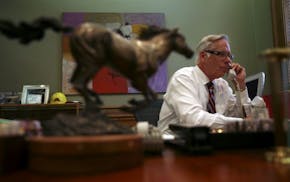Opinion editor's note: Strib Voices publishes a mix of commentary online and in print each day. To contribute, click here.
•••
Dispatches from 135 Minnesota legislative races (134 House, one Senate) have been hard to hear over the presidential-political din. But I didn't miss reports about the comments of retiring DFL state Rep. Gene Pelowski of Winona in August — and neither did the Republicans striving to regain State Capitol control.
"It would be a good thing for Minnesota if one of the two houses flipped," Pelowski said at a Minnesota Rural Electric Association summit in Bloomington, as reported by Alpha News. "I think we do need divided government to simmer things down."
Those remarks caused a minor stir. Advertently or not, Pelowski — the longest-serving member of the House DFL majority caucus — had endorsed a favorite theme among GOP legislative candidates.
Republicans have been arguing that Minnesotans should bring back something they experienced in all but two years between 1990 and 2022: a state government in which one or both of the two legislative chambers was controlled by a party other than the governor's. (No matter who wins the presidential race, Minnesota's governor in 2025 will be a DFLer.)
Pelowski later clarified that he's solidly behind Sarah Kruger, the DFL candidate to succeed him in District 26A. It's one of a handful of swing districts that are likely to determine control of the House, which now has a 68-63 DFL edge with three vacancies.
But the veteran DFLer had given aid and comfort to Republicans in other districts while invoking the spirit of an earlier era in state politics.
Minnesotans were once so keen to keep partisan politics out of their State Capitol that between 1914 and 1974, the state banned party labels from legislative ballots. Candidates chose to caucus as either Conservative or Liberal — not Republican or Democratic — after they were elected.
During the latter half of that period, the state was also home to two major parties with very similar visions and platforms. DFLers and Republicans in the 1950s and 1960s both embraced strong public education, civil rights, robust public infrastructure investment and environmental protection. Many voters considered ticket-splitting a virtue.
The most notable legislative achievement of that era — the 1971 "Minnesota Miracle" that beefed up state aid to schools and local governments in exchange for property tax relief — was a bipartisan accomplishment. It was also the product of the longest special session in state history. A half-century later, that five-month ordeal seems like a harbinger of the difficulty that bipartisan governance would later cause.
The Miracle confirmed Minnesota as a place uncommonly reliant on state-level government for services basic to the health and prosperity of its citizens. That bent went largely unchallenged in the ensuing two decades as DFLers dominated the statehouse.
By the 1990s when divided government settled in, the two political parties had grown apart in their thinking about government's rightful role and scope. What's more, congressional Republicans had shown their state counterparts that legislative obstruction could be more politically advantageous than bipartisan compromise. Partisanship became more rigid.
The result in St. Paul was persistent gridlock and diminished problem-solving capacity. Chronic problems were allowed to fester.
One example: highway funding. A decadeslong pattern of small gasoline tax increases every few years to cover the rising costs of highway building and maintenance ended in the 1990s as a "no new taxes" dictum took hold among Republicans. Reports that detailed the ensuing deterioration of state roads went unheeded.
It took a major bridge collapse in 2007 and a dramatic veto override vote in 2008 to add a nickel to the per-gallon tax, the first such increase since 1988. That was it — until 2023.
The 2023 "trifecta" session, when DFLers in the Legislature and the governor's office produced a gusher of legislation, was a dam-burst after years of frustration. It was fueled not only by pent-up progressive ambition but also by an uncommonly large pot of one-time money — itself in large measure the product of the partisan gridlock of previous years. (The 3.3-cent gas tax increase enacted in 2023 is due to go into effect on Jan. 1, 2025.)
Voters ought not expect to see another legislative year like 2023 anytime soon. But the experience of the last three decades suggests that if voters return divided government to the State Capitol, they could see more than the "simmering down" Pelowski said he would welcome. They risk a return to the inaction and dysfunction of 1990-2022.
In the next few years, Minnesotans will need to confront climate change, a persistent skilled worker shortage, an aging and diversifying population, and a brewing property tax revolt in locales where commercial property values have fallen. They deserve to face that future with the help of a state government that's reliably functional. That's what's at stake in this year's legislative contests.
Lori Sturdevant is a retired Minnesota Star Tribune editorial writer and author. Her next book, a biography of Minnesota Miracle-era DFL House Speaker Martin Sabo, is due for release next year.
Sturdevant: May the pending special session be one that inspires trust

Sturdevant: Threats to cut U research funds put Minnesota's future economy at stake


